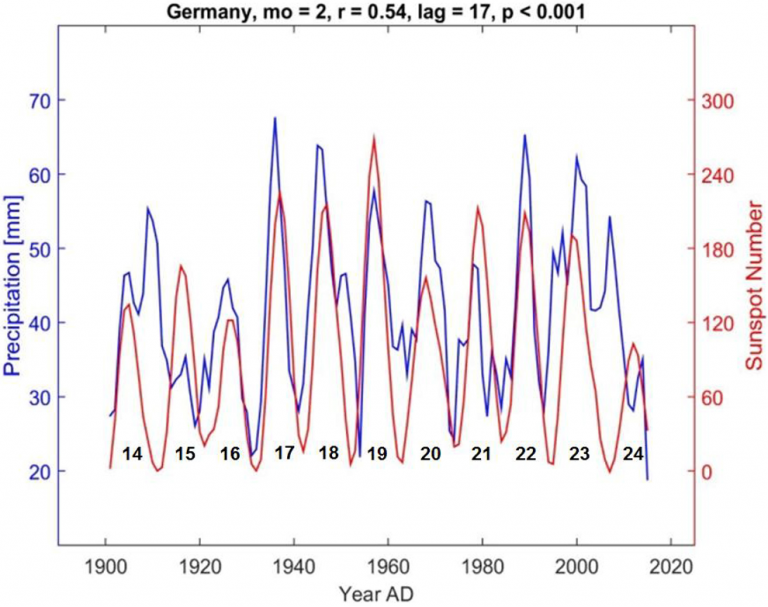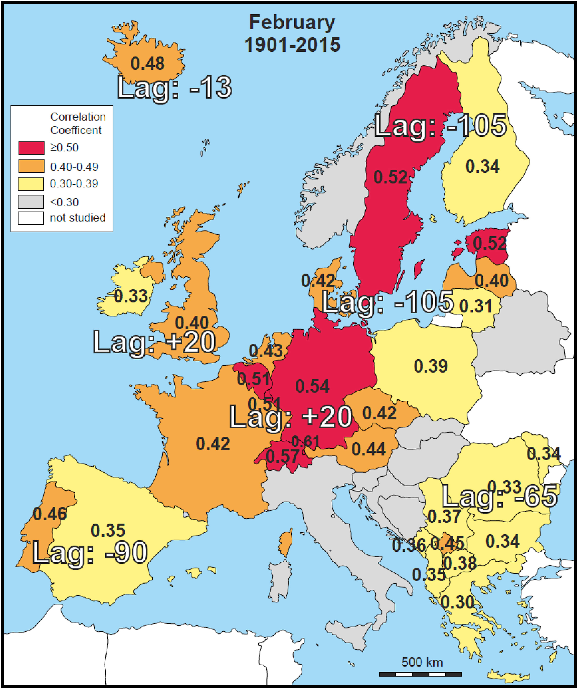A significant number of scientists say that the Earth’s climate is in large part impacted by solar activity, and less so by trace gas CO2 concentration. German scientists present new findings showing a link between solar activity and precipitation in Europe.
=================================================
How Changes on the Sun Influences Rain
A balanced level of precipitation provides the basis for a wide range of economic and social activities in Europe. Particularly agriculture, drinking water supply and inland waterway transport are directly affected. However, the amount of rain fluctuates strongly from year to year. While it may pour torrentially in one year, rain may remain absent for weeks in other year. The population is used to this variability and usually knows how to deal with it.
But what is behind the strong changes? A system, or pure atmospheric noise?
The chance discovery by an agricultural scientist from Münster, Germany, now suggests that in certain months that rain over Germany and other parts of Europe follows a pattern that up to now has remained undetected. As part of agricultural consultation, Ludger Laurenz analyzed decades of rainfall records of the weather station in Münster and noticed a constant up and down that followed an 11-year rhythm – especially in February.
Fig. 1. February precipitation in Germany compared to changes in sunspots. Shown is the optimum positive correlation (r = 0.54) with a solar lag of +17 months. Solar cycles are numbered 14–24. The probability that the correlation r = 0.54 is by chance is less than 0.1% (p < 0.001). Source: Science Direct.com.
After detailed examination it was clear that this rhythm correlated closely with the activity of the sun: the well-documented 11-year sunspot cycle.
Europe data examined
Laurenz next teamed up with two colleagues to examine the extent to which the observed pattern from Münster is reproducible in other parts of Germany and Europe, and whether the phenomenon also exists for the other months of the year. Horst-Joachim Lüdecke from the HTW University of Applied Sciences in Saarland gathered the precipitation data collected in Europe since the beginning of the 20th century. The physicist emeritus then developed a computer algorithm to determine the similarity of changes in rainfall and solar activity. All 39 European countries and every one of the 12 months of the year were quantified over a total of 115 years using mathematical correlations.
Fig. 3. Map showing the 1901–2015 most positive correlation coefficients for February precipitation and sunspots on a country-by-country basis. Pearson r values from Table 1. All maps: Lags are simplified and generally fall within ±10 months of the statistically calculated value (Table S1). Source: Science Direct.com.
In order to include possible delay effects, the data series of rain and sunspots were systematically checked for shifts. For this purpose, the time series were gradually shifted in time against each other like combs and the respective change of the correlation measure was noted. The multidimensional data obtained in this way were evaluated for systematic trends by geoscientist Sebastian Lüning and visualized cartographically. Lüning is associated with the Swiss Institute of Hydrography, Geoecology and Climate Sciences (IFHGK) and is specialized in the research of solar climate effects.
February northern Europe precipitation linked to solar activity
The mapped out results show that the link between February precipitation and solar activity originally discovered in Münster is valid for large parts of Central and Northern Europe and has very high statistical significance there. Towards southern Europe, however, the correlation weakens significantly.
4-year shift for February Central Europe precipitation
The statistical investigation was also able to demonstrate systematic phase shifts across the continent. In Germany and neighboring countries, February precipitation was particularly low when the sun was very strong four years earlier. The delay seems to be due to the slow deep circulation of the Atlantic, as earlier work suggests. On the basis of the statistically-empirically determined correlation, February 2018 in Germany with particularly low precipitation can now also be explained, which followed a particularly high intensity peak of solar activity at the beginning of 2014.
Solar signal found in other months
Similar relationships between rainfall and solar activity have been observed in a weakened way in some other months, especially in April, June and July, which account for a large part of the vegetation period in Central Europe. The result was a complex picture of the interplay of sun and rain in Europe, which showed clear trends over 1000 km and varied strongly from month to month.
Mechanism remains unclear
The study thus confirms the concept of a solar participation in the European hydroclimatic development, which had already been indicated by a whole series of local case studies of other authors. However, the exact mechanism by which the solar signal influences precipitation is still largely unclear and requires further research.
Ocean cycles also at play
The solar precipitation effect, which has now been mapped out across Europe for the first time, opens up new possibilities for improved medium-term precipitation forecasts. Agriculture in particular, but also for defense against extreme weather damage in connection with heavy rainfall and droughts, could benefit from this.
The next step in refining the forecasting methodology is a more precise quantification of the effects of Atlantic Ocean cycles, which also play an important role in rainfall, especially in Western Europe.
Original publication:
Laurenz, L., H.-J. Lüdecke, S. Lüning (2019): Influence of solar activity on European rainfall. J. Atmospheric and Solar-Terrestrial Physics, 185: 29-42, doi: 10.1016/j.jastp.2019.01.012
The pdf version can be downloaded free of charge at the following link until early March: https://authors.elsevier.com/a/1YXWZ4sIlkiVhv
Contact:
Prof. Dr. Horst-Joachim Lüdecke
Hochschule HTW des Saarlandes
moluedecke@t-online.de
Dr. habil. Sebastian Lüning
Institut für Hydrographie, Geoökologie und Klimawissenschaften (IFHGK), www.ifhgk.org
luening@ifhgk.org
Tel. 00351-961470494







What is beautiful about this is that nobody is trying to draw dramatic conclusions. Laurenz has simply followed where the science leads and found a significant (in statistical terms) correlation between rainfall and the solar cycle.
If that happens to poke a hole in somebody’s hypothesis about global warming and changing weather, too bad! By all means try to pick holes in but what’s the betting it will either be ignored or the authors vilified or more likely both when we have yet one more piece in the climate jigsaw.
And at this point nobody knows whether it is meaningless or vital!
Interesting paper and by perhaps serendipity, I have a complementary publication in the Hydrological Sciences Journal just out titled
“Application of lagged correlations between solar cycles and hydrosphere components towards sub-decadal forecasts of streamflows in the Western USA”
at:
https://www.tandfonline.com/doi/full/10.1080/02626667.2019.1567925?scroll=top&needAccess=true
sorry it is paywalled but well worth the trip to a local library.
Mike – have you put out a summary anywhere. I am very interested.
Thanks R2Dtoo, the best way to review my work is to read the full paper, as there is also some important discussion about the possible solar forced circulation patterns that could impact what I have seen and what Laurenz has reported. Simply go to Researchgate.net, and request a paper from me through that site. I can part with a few more before I exhaust the copyright allotted numbers.
Or you can email me at mwa@abeqas.com. My site there has about 30 posts over several years which all were developed in incremental support of the paper. And again I could send a copy from an email request.
Or, any can visit WUWT here:https://wattsupwiththat.com/2019/02/13/new-paper-attempts-to-link-solar-cycles-and-streamflows/
Coincidentally or not, that post by Watts about my paper is fresh and timely, although the comments are noisy. I learned of this Laurenz paper from a comment at the WUWT post.
“[T]he exact mechanism by which the solar signal influences precipitation is still largely unclear”
Solar activity is known to affect cloud formation.
One would expect that more clouds = more rain.
=! rocket science
Who would have thought that?
The big shining ball in the sky has an influence on climate😯
The bible tells us long ago that climate is ruled by the sun the moon and the stars.
People like to believe that we know better than God. But time will always prove
that we are not in control of the happenings on earth. God is in charge.
[…] P. Gosselin, February 15, 2019 in […]
[…] https://notrickszone.com/2019/02/15/new-findings-from-german-scientists-show-changes-in-precipitation… […]
[…] https://notrickszone.com/2019/02/15/new-findings-from-german-scientists-show-changes-in-precipitation… […]